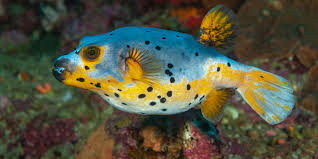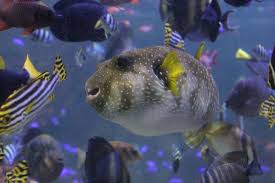Puffer Fish: The Tiny Marine Warrior with a Giant Defense
The ocean is full of incredible creatures, but few are as surprising as the puffer fish. This small, often cute-looking fish may not seem like much at first glance. However, when it feels threatened, it has one of the most dramatic responses in the animal kingdom—it transforms. In just seconds, it can inflate itself into a spiky, balloon-like ball that most predators wouldn’t dare bite.
But the puffer fish is more than just a living balloon. Its story is one of survival, strategy, and strange beauty.
A Small Fish with a Big Trick
The puffer fish belongs to a family of over 100 species, most of which live in warm ocean waters. Though they vary in size and color, all puffer fish have something in common: they can puff up when danger approaches.
This act of “puffing” is not just for show. The puffer fish quickly sucks in water to blow up its body, making itself look much larger. For many predators, this sudden transformation is enough to stop an attack.
Some puffer fish also grow sharp spines when they inflate, turning themselves into something like a floating sea urchin—unappetizing and hard to swallow.
How I Met a Puffer Fish
When I was 13, my uncle took me snorkeling during a vacation in Thailand. It was my first real look at life under the sea. I remember floating quietly when a small fish swam near my mask. As I moved closer, it suddenly puffed up like a balloon. I was both startled and amazed.
Back on the boat, our guide told us that it was a puffer fish. He smiled and said, “That little guy probably thought you were a shark.”
It was a simple moment, but it made me realize how even the smallest sea creatures have powerful ways to protect themselves.
More Than Just Puff
Blowing up isn’t the only tool in the puffer fish’s survival kit. Many species are poisonous—incredibly so. The puffer fish contains tetrodotoxin, a deadly chemical found in its organs and skin. Just a small amount of this toxin can kill a human. There’s no known antidote.
This poison keeps predators at bay. Most animals learn quickly that eating a puffer fish is a deadly mistake. Interestingly, the fish doesn’t create the toxin itself. It gets it from the bacteria in its diet.
Humans, however, are still drawn to the puffer fish—sometimes too closely.
A Dangerous Delicacy
In Japan, the puffer fish is known as fugu, and it’s served in high-end restaurants. It’s one of the few dishes in the world that can actually kill you if not prepared correctly.
Only licensed chefs are allowed to serve fugu. They spend years learning how to remove the toxic parts safely. The dish is often served raw, sliced into thin pieces.
Even with precautions, accidents still happen. Yet many people are eager to try it, calling it a once-in-a-lifetime experience.
It’s a strange twist in the puffer fish’s story: a creature designed to avoid being eaten has become one of the most dangerous foods in the world.
Puffer Fish in the Wild
The puffer fish is mostly found in shallow tropical and subtropical oceans, often near coral reefs. They enjoy hiding among rocks and sea plants, where they can stay out of sight.
They feed on a mix of algae, shellfish, and small creatures. Their strong jaws and beak-like teeth help them crush hard shells and coral.
Unlike schooling fish that swim in large groups, puffer fish are usually solitary. They move slowly and carefully, avoiding attention whenever possible.
Though they may seem shy, they’re far from boring.
The Art of Courtship
Some puffer fish species are capable of creating stunning “sand art” on the ocean floor. Male puffer fish use their fins to carve detailed circular patterns in the sand, often more than six feet wide.
These patterns are part of a mating ritual. The designs help impress females and also serve as safe spots to lay eggs.
The most amazing part? These circles are made entirely by fin movements. No tools. No help. Just instinct and effort.
Scientists only discovered this behavior in recent years, and it’s been called one of the most beautiful mysteries of the ocean.
Under Threat
Like many ocean animals, puffer fish are facing growing dangers. Pollution, climate change, and destruction of coral reefs are affecting their habitats.
Warmer ocean temperatures are causing coral reefs to bleach and die, removing the homes and hunting grounds for many species, including puffer fish.
Some species are being caught too often for food or the exotic pet trade. Others are losing their habitats to coastal development.
Protecting these unique fish means protecting the ocean itself. Conservation programs and protected marine areas are now more important than ever.
What We Can Learn from the Puffer Fish
The puffer fish is a great example of how nature rewards cleverness over size or strength. It’s not the fastest swimmer, and it doesn’t have sharp claws or big teeth. But it survives—and even thrives—thanks to smart, surprising defenses.
It teaches us that even small creatures can be powerful in their own way.
And maybe, just maybe, it reminds us that being different isn’t a weakness. It’s often the very thing that helps us survive.
Final Thoughts
The puffer fish may be small, but its story is big. It’s a creature full of secrets: from its inflatable body to its deadly poison, and even its artistic skills on the seafloor.
In a world where so many creatures rely on speed or strength, the puffer fish stands out by using surprise and smarts. It’s a quiet hero of the ocean—one that deserves our respect, curiosity, and protection.
Next time you think about marine life, think of the puffer fish. It’s proof that some of the most amazing things in the ocean don’t scream for attention—they simply puff up and float on.







